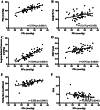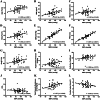Arterial stiffness indices, pulse wave velocity and central systolic blood pressure, are able to discriminate between obese and non-obese children
- PMID: 36680578
- PMCID: PMC9862226
- DOI: 10.1007/s00431-023-04807-6
Arterial stiffness indices, pulse wave velocity and central systolic blood pressure, are able to discriminate between obese and non-obese children
Abstract
The objectives of this study were to verify, first, if arterial stiffness indices can discriminate between obese and healthy children. Second, to evaluate arterial stiffness index predictors and hemodynamic parameters in obese children. Arterial stiffness indices evaluated were pulse wave velocity (PWV), central systolic blood pressure (SBPc), and central pulse pressure (PPc). A cross-sectional, descriptive, comparative study design was used. The sample consisted of 78 normal-weight children (8.1 ± 1.96 years) and 58 obese children (9.0 ± 1.87 years). PWV, PPc, and SBPc were significantly higher in the group of obese children than in the control group. The ROC curve analysis showed that maximum PWV and SBPc sensitivity and specificity in differentiating obese from non-obese children occurred at 4.09 m/s and 86.17 mmHg, respectively. PPc did not exhibit a discriminatory capacity between the two groups. Peripheral systolic blood pressure (SBPp), peripheral pulse pressure (PPp), and PPc (R2 = 0.98) were predictors of increased PWV. Augmentation pressure, PPp, and reflection coefficient (R2 = 0.873) were predictors of PPc. Age, augmentation index, total vascular resistance, cardiac index, and mean fat percentage (R2 = 0.801) were predictors of SBPc.
Conclusion: This study shows for the first time that PWV > 4.09 m/s and SBPc > 86.17 mmHg are cut-off points associated with a higher risk of obesity. These results indicate that the simple, rapid, and noninvasive measurement of arterial stiffness adds prognostic information regarding cardiovascular risk, in addition to increased body mass index.
What is known: • Overweight and obesity are strongly associated with comorbidities que contribute to the development of cardiovascular diseases.
What is new: • This is the first study to show that PWV and SBPc can discriminate obese from non-obese children. These results show that, in addition to an increased BMI, a simple, rapid, and noninvasive measurement of arterial stiffness adds prognostic information on cardiovascular risk.
Keywords: Overweight; Pediatric obesity; Pulse wave velocity; Systemic arterial hypertension; Vascular stiffness.
© 2023. The Author(s), under exclusive licence to Springer-Verlag GmbH Germany, part of Springer Nature.
Conflict of interest statement
The authors declare no competing interests.
Figures




References
-
- Risk Factor Collaboration NCD, (NCD-RisC). Worldwide trends in body-mass index, underweight, overweight, and obesity from 1975 to 2016: a pooled analysis of 2416 population-based measurement studies in 128·9 million children, adolescents, and adults. Lancet. 2017;390:2627–2642. doi: 10.1016/S0140-6736(17)32129-3. - DOI - PMC - PubMed
MeSH terms
LinkOut - more resources
Full Text Sources

